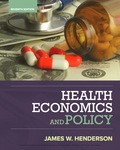Consider two prospects. Problem 1: Choose between Prospect A: $2,500 with probability 0.33 $2,400 with probability 0.66 Zero with probability 0.01 Prospect B: $2,400 with probability 1.00 Problem 2: Choose between Prospect C: $2,500 with probability 0.33 Zero with probability 0.67 Prospect D: $2,400 with probability 0.34 Zero with probability 0.66 It has been shown by Daniel Kahneman and Amos Tversky (1979, “Prospect theory: An analysis of decision under risk,” Econometrica 47(2), 263-291) that more people choose B when presented with problem 1 and when presented with problem 2, most people choose C. These choices violate expected utility theory. Why?
Consider two prospects. Problem 1: Choose between Prospect A: $2,500 with probability 0.33 $2,400 with probability 0.66 Zero with probability 0.01 Prospect B: $2,400 with probability 1.00 Problem 2: Choose between Prospect C: $2,500 with probability 0.33 Zero with probability 0.67 Prospect D: $2,400 with probability 0.34 Zero with probability 0.66 It has been shown by Daniel Kahneman and Amos Tversky (1979, “Prospect theory: An analysis of decision under risk,” Econometrica 47(2), 263-291) that more people choose B when presented with problem 1 and when presented with problem 2, most people choose C. These choices violate expected utility theory. Why?
Managerial Economics: A Problem Solving Approach
5th Edition
ISBN:9781337106665
Author:Luke M. Froeb, Brian T. McCann, Michael R. Ward, Mike Shor
Publisher:Luke M. Froeb, Brian T. McCann, Michael R. Ward, Mike Shor
Chapter17: Making Decisions With Uncertainty
Section: Chapter Questions
Problem 17.5IP
Related questions
Question
Consider two prospects.
Problem 1: Choose between
|
Prospect A: |
$2,500 with probability |
0.33 |
|
|
$2,400 with probability |
0.66 |
|
|
Zero with probability |
0.01 |
|
Prospect B: |
$2,400 with probability |
1.00 |
Problem 2: Choose between
|
Prospect C: |
$2,500 with probability |
0.33 |
|
|
Zero with probability |
0.67 |
|
Prospect D: |
$2,400 with probability |
0.34 |
|
|
Zero with probability |
0.66 |
It has been shown by Daniel Kahneman and Amos Tversky (1979, “Prospect theory: An analysis of decision under risk,” Econometrica 47(2), 263-291) that more people choose B when presented with problem 1 and when presented with problem 2, most people choose C. These choices violate expected utility theory. Why?
Expert Solution
This question has been solved!
Explore an expertly crafted, step-by-step solution for a thorough understanding of key concepts.
Step by step
Solved in 3 steps with 1 images

Recommended textbooks for you

Managerial Economics: A Problem Solving Approach
Economics
ISBN:
9781337106665
Author:
Luke M. Froeb, Brian T. McCann, Michael R. Ward, Mike Shor
Publisher:
Cengage Learning


Managerial Economics: Applications, Strategies an…
Economics
ISBN:
9781305506381
Author:
James R. McGuigan, R. Charles Moyer, Frederick H.deB. Harris
Publisher:
Cengage Learning

Managerial Economics: A Problem Solving Approach
Economics
ISBN:
9781337106665
Author:
Luke M. Froeb, Brian T. McCann, Michael R. Ward, Mike Shor
Publisher:
Cengage Learning


Managerial Economics: Applications, Strategies an…
Economics
ISBN:
9781305506381
Author:
James R. McGuigan, R. Charles Moyer, Frederick H.deB. Harris
Publisher:
Cengage Learning


Essentials of Economics (MindTap Course List)
Economics
ISBN:
9781337091992
Author:
N. Gregory Mankiw
Publisher:
Cengage Learning

Brief Principles of Macroeconomics (MindTap Cours…
Economics
ISBN:
9781337091985
Author:
N. Gregory Mankiw
Publisher:
Cengage Learning